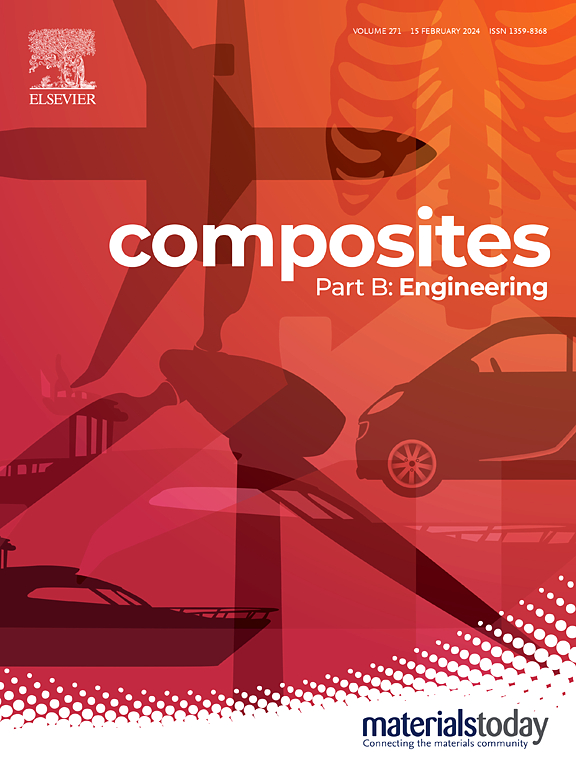Tailoring MoP/Rh2P-embedded BNFS-doped carbon nanofibers for supercapacitors via DFT-guided electronic and ion adsorption engineering
IF 12.7
1区 材料科学
Q1 ENGINEERING, MULTIDISCIPLINARY
引用次数: 0
Abstract
Enhancing electrochemical performance through synergistic redox activity and improved electronic conductivity is crucial for high-efficiency supercapacitors. To achieve this, a dual metal phosphide-integrated, heteroatom-doped carbon nanofiber composite (MoP/Rh2P@BNFS–CNF) was synthesized via electrospinning followed by in situ phosphidation. The integration of B, N, F and S heteroatoms using ionic liquids, combined with embedded MoP and Rh2P nanoparticles, resulted in a highly porous and conductive nanostructure with an average fiber diameter of 362 nm and nanoparticle sizes ranging from 10 to 20 nm. Structural and surface analyses confirmed uniform heteroatom doping and successful phosphide formation. The optimized composite exhibited a high surface area (1050.11 m2 g−1), superior wettability (contact angle: 3.79o), and exceptional electrochemical performance, delivering specific capacitance of 937.5 F g−1 (CV) and 548 C g−1 (GCD) at 1 A g−1. It also demonstrated excellent rate capability, 97.1 % capacitance retention over 5000 cycles, and the lowest Rs (0.86 Ω) and Rct (1.01 Ω) among the tested electrodes. Density functional theory (DFT) calculations confirmed its metallic nature with no bandgap, high electronic density near the Fermi level, and strong K+ adsorption (62 sites), validating the composite's excellent conductivity and electrochemical stability. The assembled asymmetric supercapacitor device (ASD) achieved a wide voltage window (0–1.8 V), a high energy density of 27.5 Wh kg−1, a power density of 9000 W kg−1, and 97.3 % capacitance retention over 10,000 cycles. These results demonstrate the potential of MoP/Rh2P@BNFS–CNF as a next-generation electrode for high-performance energy storage applications.

通过dft引导电子和离子吸附工程,为超级电容器定制嵌入MoP/ rh2p的bnfs掺杂碳纳米纤维
通过协同氧化还原活性和提高电导率来提高电化学性能是高效超级电容器的关键。为了实现这一目标,通过静电纺丝和原位磷化合成了双金属磷化集成、杂原子掺杂的碳纳米纤维复合材料(MoP/Rh2P@BNFS -CNF)。利用离子液体将B、N、F和S杂原子整合,再结合内嵌的MoP和Rh2P纳米粒子,得到了平均纤维直径为362 nm、纳米颗粒尺寸为10 ~ 20 nm的高多孔性和导电性纳米结构。结构和表面分析证实了均匀的杂原子掺杂和成功的磷化物形成。优化后的复合材料具有高表面积(1050.11 m2 g−1)、优异的润湿性(接触角:3.79)和优异的电化学性能,在1 a g−1时的比电容为937.5 F g−1 (CV)和548 C g−1 (GCD)。它还表现出优异的倍率性能,在5000次循环中,97.1%的电容保持率,以及最低的Rs (0.86 Ω)和Rct (1.01 Ω)。密度泛函理论(DFT)计算证实了它的金属性质,没有带隙,费米能级附近的电子密度高,K+吸附强(62个位点),验证了复合材料优异的导电性和电化学稳定性。组装的非对称超级电容器器件(ASD)具有宽电压窗(0-1.8 V)、27.5 Wh kg−1的高能量密度、9000 W kg−1的功率密度和97.3%的循环容量保持率。这些结果证明了MoP/Rh2P@BNFS -CNF作为下一代高性能储能电极的潜力。
本文章由计算机程序翻译,如有差异,请以英文原文为准。
求助全文
约1分钟内获得全文
求助全文
来源期刊

Composites Part B: Engineering
工程技术-材料科学:复合
CiteScore
24.40
自引率
11.50%
发文量
784
审稿时长
21 days
期刊介绍:
Composites Part B: Engineering is a journal that publishes impactful research of high quality on composite materials. This research is supported by fundamental mechanics and materials science and engineering approaches. The targeted research can cover a wide range of length scales, ranging from nano to micro and meso, and even to the full product and structure level. The journal specifically focuses on engineering applications that involve high performance composites. These applications can range from low volume and high cost to high volume and low cost composite development.
The main goal of the journal is to provide a platform for the prompt publication of original and high quality research. The emphasis is on design, development, modeling, validation, and manufacturing of engineering details and concepts. The journal welcomes both basic research papers and proposals for review articles. Authors are encouraged to address challenges across various application areas. These areas include, but are not limited to, aerospace, automotive, and other surface transportation. The journal also covers energy-related applications, with a focus on renewable energy. Other application areas include infrastructure, off-shore and maritime projects, health care technology, and recreational products.
 求助内容:
求助内容: 应助结果提醒方式:
应助结果提醒方式:


